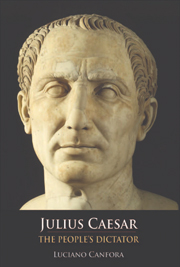Book contents
- Frontmatter
- Contents
- Translators' Note
- Acknowledgements
- Foreword
- PART I FROM SULLA TO CATILINE
- PART II FROM THE TRIUMVIRATE TO THE CONQUEST OF GAUL
- PART III THE LONG CIVIL WAR
- 16 Towards the Crisis
- 17 Striving after Tyranny?
- 18 Attacking the World with Five Cohorts
- 19 Caesar's ‘Programme’: In Search of Consensus
- 20 ‘Amicitia’
- 21 From the Rubicon to Pharsalus
- 22 Against Subversion
- 23 Alexandria
- 24 Caesar Saved by the Jews
- 25 From Syria to Zela
- 26 The Long Civil War
- 27 The Shoot of a Palm Tree: The Young Octavius Emerges
- 28 ‘Anticato’
- PART IV FROM THE CONSPIRACY TO THE TRIUMPH OF CAESARISM
- Chronology
- Bibliography
- Index
21 - From the Rubicon to Pharsalus
from PART III - THE LONG CIVIL WAR
Published online by Cambridge University Press: 05 August 2013
- Frontmatter
- Contents
- Translators' Note
- Acknowledgements
- Foreword
- PART I FROM SULLA TO CATILINE
- PART II FROM THE TRIUMVIRATE TO THE CONQUEST OF GAUL
- PART III THE LONG CIVIL WAR
- 16 Towards the Crisis
- 17 Striving after Tyranny?
- 18 Attacking the World with Five Cohorts
- 19 Caesar's ‘Programme’: In Search of Consensus
- 20 ‘Amicitia’
- 21 From the Rubicon to Pharsalus
- 22 Against Subversion
- 23 Alexandria
- 24 Caesar Saved by the Jews
- 25 From Syria to Zela
- 26 The Long Civil War
- 27 The Shoot of a Palm Tree: The Young Octavius Emerges
- 28 ‘Anticato’
- PART IV FROM THE CONSPIRACY TO THE TRIUMPH OF CAESARISM
- Chronology
- Bibliography
- Index
Summary
The start of the civil conflict is a kind of ‘phoney war’. After the occupation of Picenum, Umbria and Etruria, and the humiliation of L. Domitius Ahenobarbus, who expected to succeed Caesar as governor of Gaul (and instead was ridiculed after his unsuccessful defence of Corfinium), Caesar hastened down the Adriatic coast as far as Brindisi to attempt to block Pompey's flight from Italy. When this failed – Pompey successfully crossed to Durazzo (Dyrrhachium) on 17 March 491 – Caesar ‘lost’ his enemy for some time. He hurried back to Rome to consolidate, first, the conquest of Italy. This hectic start was followed by a period of deadlock, or rather, of waiting: the fast-moving ‘mobile warfare’ so dear to Caesar gave way to a tedious and lasting standstill. Strategic objectives were temporarily changed. Caesar busied himself with consolidating his hold on Italy and the West, while Pompey set about building a great army in Greece and Macedonia.
How did this paradoxical situation come about? Pompey had deceived his friends when he said, with his usual air of superiority towards the rest of the world, that he had only to give the signal by stamping his foot and ‘whole armies would rise up out of the ground’. After this he decided to leave Italy to his enemy and try to build an ‘invincible’ army in Greece.
- Type
- Chapter
- Information
- Julius CaesarThe People's Dictator, pp. 165 - 183Publisher: Edinburgh University PressPrint publication year: 2007



